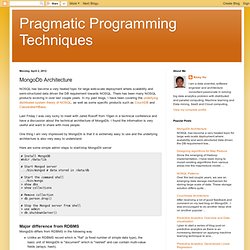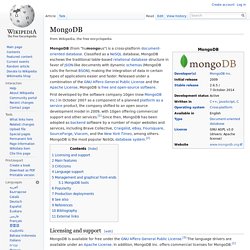

MongoDb Architecture. NOSQL has become a very heated topic for large web-scale deployment where scalability and semi-structured data driven the DB requirement towards NOSQL.

There has been many NOSQL products evolving in over last couple years. In my past blogs, I have been covering the underlying distributed system theory of NOSQL, as well as some specific products such as CouchDB and Cassandra/HBase. Last Friday I was very lucky to meet with Jared Rosoff from 10gen in a technical conference and have a discussion about the technical architecture of MongoDb. I found the information is very useful and want to share with more people. One thing I am very impressed by MongoDb is that it is extremely easy to use and the underlying architecture is also very easy to understand.
MongoDB Hosting. MongoDB. MongoDB (from "humongous") is a cross-platform document-oriented database.

Classified as a NoSQL database, MongoDB eschews the traditional table-based relational database structure in favor of JSON-like documents with dynamic schemas (MongoDB calls the format BSON), making the integration of data in certain types of applications easier and faster. Released under a combination of the GNU Affero General Public License and the Apache License, MongoDB is free and open-source software. First developed by the software company 10gen (now MongoDB Inc.) in October 2007 as a component of a planned platform as a service product, the company shifted to an open source development model in 2009, with 10gen offering commercial support and other services.[1] Since then, MongoDB has been adopted as backend software by a number of major websites and services, including Brave Collective, Craigslist, eBay, Foursquare, SourceForge, Viacom, and the New York Times, among others.
Licensing and support[edit] MongoDB.